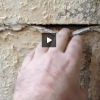Interior Waterproofing
Please read the page Why Foundations Leak before proceeding here as the information covered there is foundational to understanding the following material.
The following are different popular solutions to waterproofing along with their benefits and drawbacks.
Paint Products
Waterproofing paint products are a very popular solution to waterproofing basement walls other below ground concrete areas. These paints must be applied to a clean and dry wall. The wall must be cleaned thoroughly of any loose mortar (this is very difficult to achieve since mortar once brittle/flaky only proves more crumbly the deeper you scrape). Every one of the paint products on the market including the heavier commercial ones are really only designed to give the appearance of a clean, dry and mold free wall. If the wall becomes damp in any way whether from preexisting conditions or arising from a new source the paint, now dry and brittle, will quickly and readily flake off the wall. Water (one of the smallest molecule on earth) simply goes right through any paint molecule. Paints are not a solid mass as are vinyl vapor barriers. In all, these products really only give a very temporary solution if there is only slight moisture not real water. If an area is leaking water in any substantial amount then these products will serve no purpose at all, although large portions of the upper wall will still look very clean for many months.
The sad reality is that these products will prevent a wall from properly drying. This accelerates mortar and block decay.
So what are these types of paint products best suited for? They are much better suited for concrete wall in areas that rarely if ever get damp and/or are not more than a foot below ground. The bright color will liven up a room flanked with only gray cinder block walls. If the walls only get damp every few years then the paint will last and look great. Still, even considering this ideal situation the bottom portion of the wall will still peal and flake after just a few years due to moisture in the lower parts of the wall. Visit these links for more images of wall leaks and concrete wall leaking.
Vapor Barriers
Often you will see a contractor or remodeler apply a plastic sheeting on a wall either behind the studs or, unbelievably, in front of the studs. You rarely see a builder do this. The thinking is that this barrier of plastic will keep moisture from the ground/wall from entering the basement. This is correct. But, if the vapor barrier just sits on the floor then any moisture will accumulate there, either pooling or being soaked up by carpet, drywall, tile grout etc. For vapor barriers to have any permanent and real effect they must be applied directly to the foundation wall either with liquid nails or wall clips then they must terminate below the floor to a subfloor drainage system.
In the photo below you can see the white vapor barrier on the wall and the dimpled black plastic commonly called MiraDrain that allows for drainage to the system under the floor.
Interior Waterproofing Systems
The image below is one of the most comprehensive basement waterproofing solutions. Here you have a section of floor removed to install a 4 inch drainage pipe. A vinyl vapor barrier is then installed running down the wall to the system below the floor. The drainage pipe itself terminates into a sump well that collects the water and also houses a pump that then pumps the water upward and outside away from the house.
This technique of sheeting the wall with vapor barrier and running it beneath the floor to a sub floor system is considered by any company that warranties against wall dampness to be the surest way to guarantee water from entering a finished below ground area. This is not to say that outside system do not have any merit, but that it is almost impossible for these types of interior systems to fail. Unless..
The sump pump fails.
Interior waterproofing systems must rely on a sump pump to push the collected water outside and away from the foundation if the electricity goes out or the pump stops operating for whatever reason the water can flood out of the sump well (this is relatively contained and much better than the whole foundation leaking, but can still be a mess.) This problem can be prevented with the use of battery back-up sump pumps (even though they are known to be quite often very finicky). Better than a battery back up pump would be a back up generator. The best solution is to not give a sump well more than 120 ft. of system to collect and drain. The idea here is that the many feet of pipe and the wells themselves can hold a lot of water and can endure the lack of operation of one of the pumps due to failure or electrical outage for many hours or days barring excessive flooding.


